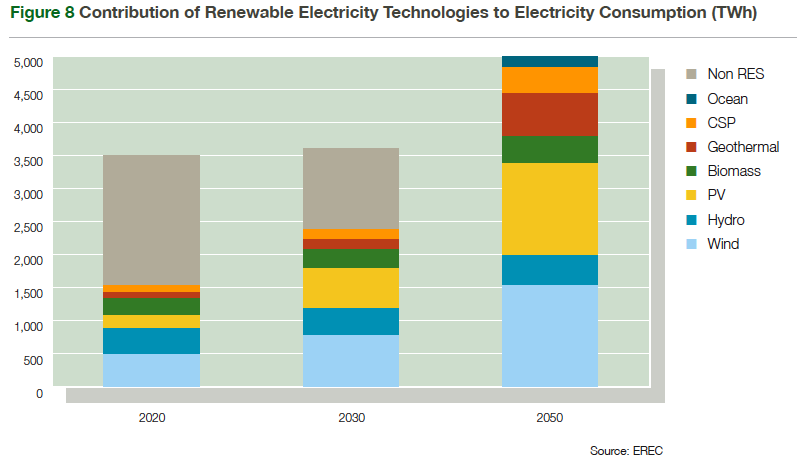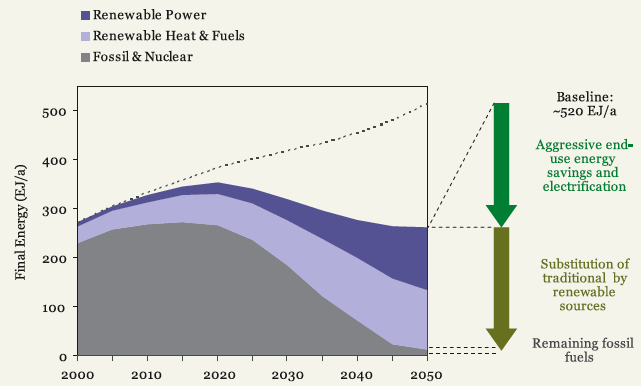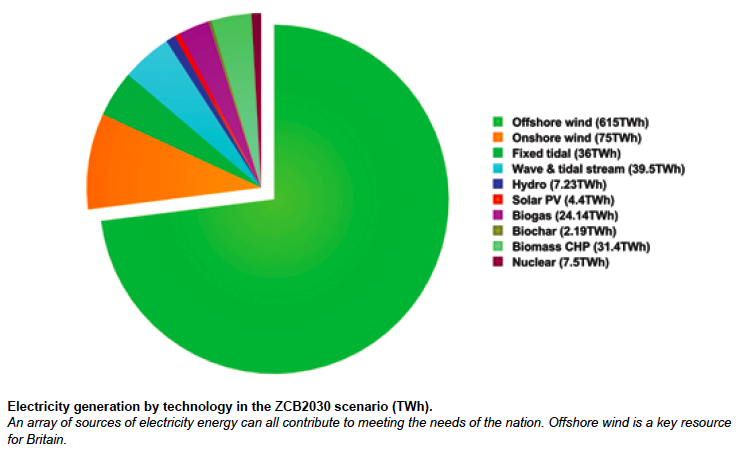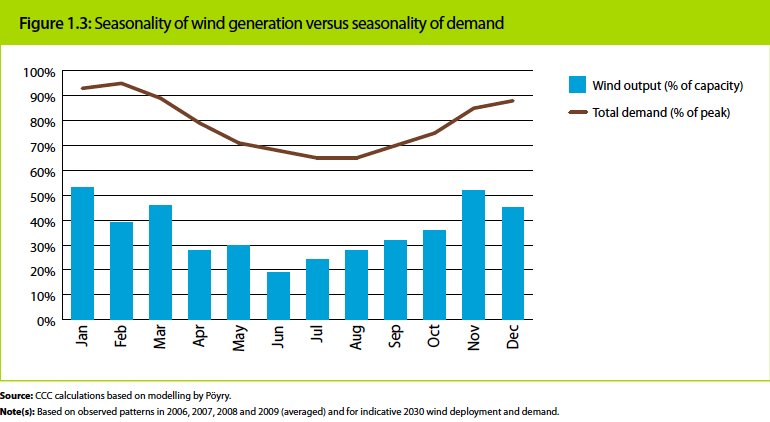Can renewables provide baseload power?
What The Science Says:
Numerous case studies on both regional and global scales have determined that renewable energy, if properly implemented, can provide baseload power.
Climate Myth: Renewables can't provide baseload power
The myth that renewable energy sources can't meet baseload (24-hour per day) demand has become quite widespread and widely-accepted. After all, the wind doesn't blow all the time, and there's no sunlight at night. However, detailed computer simulations, backed up by real-world experience with wind power, demonstrate that a transition to 100% energy production from renewable sources is possible within the next few decades.
Reducing Baseload Demand
Firstly, we currently do not use our energy very efficiently. For example, nighttime energy demand is much lower than during the day, and yet we waste a great deal of energy from coal and nuclear power plants, which are difficult to power up quickly, and are thus left running at high capacity even when demand is low. Baseload demand can be further reduced by increasing the energy efficiency of homes and other buildings.
Renewable Baseload Sources
Secondly, some renewable energy sources are just as reliable for baseload energy as fossil fuels. For example, bio-electricity generated from burning the residues of crops and plantation forests, concentrated solar thermal power with low-cost thermal storage (such as in molten salt), and hot-rock geothermal power. In fact, bio-electricity from residues already contributes to both baseload and peak-load power in parts of Europe and the USA, and is poised for rapid growth. Concentrated solar thermal technology is advancing rapidly, and a 19.9-megawatt solar thermal plant opened in Spain in 2011 (
Gemasolar), which stores energy in molten salt for up to 15 hours, and is thus able to provide energy 20 hours per day on average, and 24 hours per day during much of the summer.
Addressing Intermittency from Wind and Solar
Wind power is currently the cheapest source of renewable energy, but presents the challenge of dealing with the intermittency of windspeed. Nevertheless, as of 2011, wind already supplies 24% of Denmark's electricity generation, and over 14% of Spain and Portugal's.
Although the output of a single wind farm will fluctuate greatly, the fluctuations in the total output from a number of wind farms geographically distributed in different wind regimes will be much smaller and partially predictable. Modeling has also shown that it's relatively inexpensive to increase the reliability of the total wind output to a level equivalent to a coal-fired power station by adding a few low-cost peak-load gas turbines that are opearated infrequently, to fill in the gaps when the wind farm production is low (
Diesendorf 2010). Additionally, in many regions, peak wind (see Figure 4 below) and solar production match up well with peak electricity demand.
Current power grid systems are already built to handle fluctuations in supply and demand with peak-load plants such as hydroelectric and gas turbines which can be switched on and off quickly, and by reserve baseload plants that are kept hot. Adding wind and solar photovoltaic capacity to the grid may require augmenting the amount of peak-load plants, which can be done relatively cheaply by adding gas turbines, which can be fueled by sustainably-produced biofuels or natural gas.
Recent studies by the US National Renewable Energy Laboratory found that wind could supply 20-30% of electricity, given improved transmission links and a little low-cost flexible back-up.
As mentioned above, there have been numerous regional and global case studies demonstrating that renewable sources can meet all energy needs within a few decades. Some of these case studies are summarized below.
Global Case Studies
Energy consulting firm
Ecofys produced a report detailing
how we can meet nearly 100% of global energy needs with renewable sources by 2050. Approximately half of the goal is met through increased energy efficiency to first reduce energy demands, and the other half is achieved by switching to renewable energy sources for electricity production (Figure 1).
Figure 1: Ecofys projected global energy consumption between 2000 and 2050
Stanford's Mark Jacobson and UC Davis' Mark Delucchi (J&D) published a study in 2010 in the journal
Energy Policy examining the possibility of meeting all global energy needs with wind, water, and solar (WWS) power. They find that
it would be plausible to produce all new energy from WWS in 2030, and replace all pre-existing energy with WWS by 2050.
In
Part I of their study, J&D examine the technologies, energy resources, infrastructure, and materials necessary to provide all energy from WWS sources. In
Part II of the study, J&D examine the variability of WWS energy, and the costs of their proposal. J&D project that when accounting for the costs associated with air pollution and climate change, all the WWS technologies they consider will be cheaper than conventional energy sources (including coal) by 2020 or 2030, and in fact onshore wind is already cheaper.
European Union Case Study
The European Renewable Energy Council (EREC) prepared a plan for the European Union (EU) to meet 100% of its energy needs with renewable sources by 2050, entitled
Re-Thinking 2050. The EREC plan begins with an average annual growth rate of renewable electricity capacity of 14% between 2007 and 2020. Total EU renewable power production increases from 185 GW in 2007 to 521.5 GW in 2020, 965.2 GW in 2030, and finally 1,956 GW in 2050. In 2050, the proposed EU energy production breakdown is: 31% from wind, 27% from solar PV, 12% from geothermal, 10% from biomass, 9% from hydroelectric, 8% from solar thermal, and 3% from the ocean (Figure 2).
 Figure 2: EREC report breakdown of EU energy production in 2020, 2030, and 2050
Northern Europe Case Study
Sørensen (2008)
Figure 2: EREC report breakdown of EU energy production in 2020, 2030, and 2050
Northern Europe Case Study
Sørensen (2008) developed a plan through which a group of northern European countries (Denmark, Norway, Sweden, Finland, and Germany) could meet its energy needs using primarily wind, hydropower, and biofuels. Due to the high latitudes of these countries, solar is only a significant contributor to electricity and heat production in Germany. In order to address the intermittency of wind power, Sørensen proposes either utilizing hydro reservoir or hydrogen for energy storage, or importing and exporting energy between the northern European nations to meet the varying demand. However, Sørensen finds:
"The intermittency of wind energy turns out not to be so large, that any substantial trade of electric power between the Nordic countries is called for. The reasons are first the difference in wind regimes...and second the establishment of a level of wind exploitation considerably greater that that required by dedicated electricity demands. The latter choice implies that a part of the wind power generated does not have time-urgent uses but may be converted (e.g. to hydrogen) at variable rates, leaving a base-production of wind power sufficient to cover the time-urgent demands."
../2






